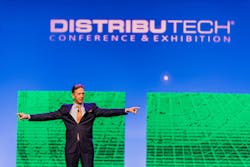DistribuTECH Keynotes: Opportunities, 'New Era' Define Electric Utilities Future
Keynote speakers at DistribuTECH in New Orleans in early February heralded a “new era” for electric utilities of today and tomorrow, citing numerous new opportunities, new technologies and new partnerships, along with increased customer interactions and expectations.
In his opening keynote, Philip Mezey, president and CEO of Itron, proclaimed, “the future is now,” citing a rapidly differentiating generation mix, new ways for electric companies to interact with their customers and a “wonderful opportunity of electrification” that will herald a two-way grid between utilities and customers.
While these developments offer enticing possibilities for utilities and their business partners, Mezey suggested the new era will also generate new questions. “How does the technology improve reliability?” he asked. “There are also going to be security and privacy concerns, and how does connecting the grid improve storm resiliency?”
The answers to these questions are yet to be found, Mezey said, but attendees could begin by looking at various offerings from numerous companies on the show floor.
“I wish you a curious, interesting and engaged week!” he said.
Paul Hinnenkamp, executive vice president and chief operating officer of the local host utility, Entergy, offered that utilities today need to manage a transition from supplier to partner, with an observation that “customers buy outcomes, not electricity.”
Hinnenkamp pointed to an estimated 1000 MW of renewables entering the grid over the next several years.
He also cited the example of Netflix vs. Blockbuster over the past 20 years, saying Blockbuster started with a huge advantage in terms of customers for rental videos in the 1980s and 1990s, but 20 years later Netflix has an estimated 137 million users while Blockbuster is down to zero.
“This is an example of how fast things can change,” Hinnenkamp claimed, adding that the utility business is hardly exempt from such market forces, particularly as the industry continues to move to greater and more differentiated services on the customer side of the meter.
Entergy's grid modernization projects call for the installation of up to 3 million automated meters over the next several years, Hinnekamp noted. "This effort will enhance reliability and allow for more accurate detection of problems and faster response times," he stated. "These meters will also provide our customers with new, transparent energy management tools and enable us to offer new energy-saving programs."
Hinnenkamp closed with his own admonition: “If our world is going to be disrupted, let’s disrupt it ourselves!”
Terence Donnelly, president and chief operating officer of Commonwealth Edison, capped off the morning keynotes by claiming “we are not in the utility business any more,” and that electric utilities have entered a “new era of power.”
Utility companies, Donnelly continued, have been previously defined as companies that “provide a useful basic service” like electricity or water. Not so today or in the future, he says. Renewables are offering choice in generation, cities are de-carbonizing and electrification will march ahead with enormous demand for electric chargers and flexible usage charges. “It may seem insurmountable [to make all these changes], but we will as an industry adopt,” he said. “We have to.”
As an example, Donnelly cited Com Ed’s smart streetlights initiative. “An icon of quality of life gets smart,” he said of smart streetlights that not only provide safe illumination, but also offer communications software for energy savings and predictive maintenance, as well as cellular phone service and community Wi-Fi.
The utility company of today and tomorrow, Donnelly continued, will also do more than expand its interactions with customers. “It will change our regulatory compact and impact,” he said. “It is going to change how we recruit talent.”
Donnelly spoke about Com Ed’s Bronzeville (Chicago) neighborhood microgrid as an example of how his utility is changing to reflect the changing times. Bronzeville, he said, started as a microgrid to serve 7 MW of distributed load to about 1000 customers, but ended up representing a “town square” of community services, including public information kiosks, public EV charging and information on STEM (Science Technology Engineering and Math) education programs to train future utility workers.
“Expectations are changing and increasing,” Donnelly concluded. “To succeed we need to be in the business of making connections. Our future is bright indeed in the new era of power.”
